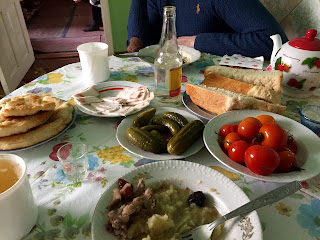
Russia’s Minister of Agriculture, Alexander Tkachev, reported
to the plenary session of the Federation Council on the preliminary results for
the agricultural sector 2016.
He started of by saying that although the country is going
through a difficult economic period, agriculture is providing a bed of
stability, which is not something you often hear said about farming.
He then referenced the continued government support for the
industry before going on to highlight this year’s grain crop of 117mmt which is
the highest for the last forty years.
To further ensure food security he talks about horticultural
output, specifically the production of greenhouse vegetables. The Minister states that it is necessary to
increase production by one million tonnes by 2020 which will require the
construction and modernisation of two thousand hectares of greenhouses for the
next five years. (If you build and commission
greenhouses, now might be a good time to apply for a Russian business visa).
Fruit was the next topic with similar talk of increased productivity this time by 30% with an extra 72 thousand hectares of orchards which
will increase fruit production to 500 thousand tonnes in five years’ time. Sounds easy when you put it like that.
He then highlights the 2016 livestock sector so far
including a 5% increase in livestock and poultry output, 14 million tonnes of live weight produced, meat exports growing by 60% and exceededing 150 thousand tonnes.
This is followed by forecasts including an increase in cattle
and poultry live weight production by 10% that will reach almost 15 million
tonnes by 2020.
Milk production is forecast to increase by 3% per year, domestic dairy
products increase to 7 million tonnes by 2020 (replacing 4 million tonnes
currently imported from Belarus so no quarter given there to the Eurasian Economic Union).
To achieve this extra productivity in the dairy sector it
will be necessary, naturally, to modernise the existing production facilities
which will be achieved through a series of direct and indirect subsidies, intervention
to form fair prices for milk (like that works), protect domestic producers from
unfair competition (selective use of WTO?), work with the Customs Union on technical regulations, increase
fines and adjust the balance and volumes of dairy products imported into
Russian.
In other words plenty of carrot, plenty of stick.
Farm machinery and the policy is more of the same; continued
state support for manufacturers; domestic equipment purchases increasing from
40% to 55% and a pledge to maintain the level of subsidies for agricultural
machinery to keep pace with the acquisition of new agricultural machinery as
old kit is disposed. (If you’re an
international machinery manufacturer or dealer, probably no need to apply for
that new Russian visa).
There was then talk of streamlining and simplifying the subsidy
administration with a unified regional subsidy beginning in 2017.
So, there you have it, the Russian agricultural policy for
the next few years will be a bit like a matreshka doll, a gift that just keeps giving.




















